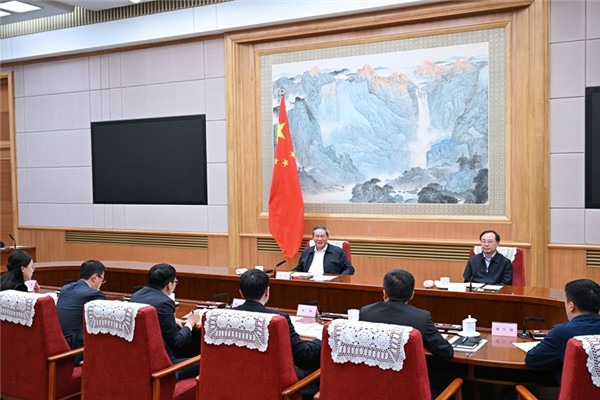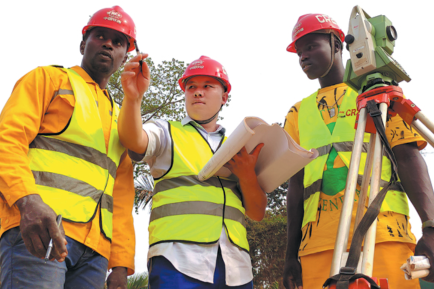Satellite communication takes leap into future
Strategically vital sector at forefront of China's digital transformation, bridging digital divide, securing nation's position as global leader in telecommunications


In an era where digital connectivity defines the pace of global progress, China is marking big strides in satellite communication.
Backed by robust government policies, State-owned enterprises, and a growing number of private companies, the country is determined to carve out a significant presence in this nascent yet strategically vital industry.
The satellite communication sector, once a niche domain, is now at the forefront of China's digital transformation, promising to bridge the digital divide and secure its position as a global leader in telecommunications.
To seize the critical opportunity for high-quality development of the satellite communication industry, the Ministry of Industry and Information Technology recently issued a guideline that outlines goals to achieve large-scale application of new models and formats such as direct smartphone-satellite connectivity by 2030, with satellite communication users exceeding 10 million.
The comprehensive document also outlines 19 specific measures across six key areas, aiming to optimize the licensing process for satellite communication services, regulate the opening of these services and propel the industry toward sustained growth.
The MIIT officially awarded China Unicom and China Mobile licenses to operate satellite mobile communication services last month, in a signal that the country is optimizing market access to promote the development of the satellite communication industry. China Telecom, the other Big Three telecom operator in the country, already has such a license.
The MIIT document also underscores the importance of satellite communication in ensuring national space security and advancing the development of 6G technology, where the integration of space and terrestrial networks (known as "space-terrestrial fusion") is a defining feature.
Deng Wei, director of the space-terrestrial fusion technology research institute at the China Mobile Research Institute, said the move by the MIIT represents a forward-looking strategy to align China's satellite communication sector with global trends. It also serves as a strategic blueprint for the future of the industry, offering clear guidance for stakeholders aiming to build integrated space-terrestrial networks.
The document proposes several transformative measures to stimulate the growth of the satellite communication industry. These include supporting telecom operators in developing terminal devices that can directly connect to satellites, leveraging high and low Earth orbit, or LEO, satellite resources through shared infrastructure, and accelerating the transition of satellite communication applications from specialized to mass-market use. Additionally, the MIIT calls for the creation of new types of satellite communication services and further opening up opportunities for private enterprises.
Experts have lauded these measures, noting that the "State-owned + private-owned" partnership model reflects China's commitment to fostering a dynamic and inclusive industrial ecosystem. By encouraging collaboration between State-owned enterprises and private companies, the guideline aims to unlock innovation and drive the sector's expansion.
Li Xiayu, an engineer at the China Academy of Information and Communications Technology, said the document will catalyze innovation in the satellite communication industry. By supporting the development of satellite internet, satellite-connected smartphones, and satellite internet of things, the MIIT will enhance infrastructure, improve service capabilities, and ensure comprehensive coverage across the country.
The importance of satellite communication is not limited to China; it is a global imperative.
According to data from the International Telecommunication Union, nearly 2.6 billion people worldwide — about one-third of the global population — remained unconnected to the internet as of end-2024.
Remote mountainous regions, oceans and deserts continue to suffer from inadequate or nonexistent connectivity, often referred to as "signal deserts".
Satellite communication, particularly LEO satellite internet, offers a solution to this challenge by providing low-latency, high-bandwidth connectivity that can seamlessly cover these underserved areas. It is poised to address the "last mile "problem and bridge the digital divide, serving as a critical enabler of global connectivity.
The global satellite communication landscape is evolving rapidly, with countries and companies investing heavily in satellite constellations. In the United States, SpaceX has launched over 9,100 Starlink satellites, with approximately 8,200-8,300 satellites actively in orbit. By March 2025, Starlink had surpassed 6 million users across more than 120 countries and regions.
The UK's OneWeb has deployed 648 LEO satellites, establishing the world's second-largest LEO constellation. Meanwhile, Canada's Telesat is developing the Lightspeed constellation, comprising 198 satellites, to deliver a hybrid network that balances local coverage with global reach.
China, though a late entrant, is rapidly catching up.
In 2021, the country established China Satellite Network Group Co Ltd, an initiative focused on building an LEO satellite constellation. Companies like China Satellite Network Group Co Ltd and Spacesail are driving this ambitious project forward. However, the gap between China and global leaders remains significant, underscoring the need for accelerated development, experts said.
The satellite communication market in China is experiencing rapid growth. According to a report by AskCI Consulting, the market size reached 35.3 billion yuan ($495.6 million) in 2024 and is projected to grow to 37.6 billion yuan this year.
Li from the China Academy of Information and Communications Technology attributes this growth to the convergence of favorable policies, technological advancements and expanding applications, which are collectively propelling the sector into a phase of rapid development.
China Satellite Network Group Co Ltd achieved a major milestone in December 2024 with the successful launch of its first batch of LEO satellites, which entered their designated orbits seamlessly. Since July, the company has accelerated its satellite deployment, launching satellites in rapid succession and setting a record for high-density satellite constellation construction in China.
Chinese telecom operators are at the forefront of this transformation.
China Telecom, for instance, made history in September 2023 by launching the world's first satellite-direct smartphone service. In April 2024, it pioneered satellite-direct connectivity for vehicles. By May, China Telecom had expanded its satellite-direct smartphone service to Laos, marking its entry into the international market.
China Mobile is also actively advancing its satellite communication initiatives, undertaking national projects and leading the development of global standards. The company has established a cutting-edge space-terrestrial network integration system and collaborated with China Satellite Network Group Co Ltd to launch the Beidou messaging service. As of now, the service has attracted over 490,000 users, with more than 16 million terminals connected.
During severe floods in Beijing earlier this summer, China Mobile provided free Beidou messaging services, enabling users to send location-based distress calls even in areas without traditional network coverage.
Deng from China Mobile said that the company will continue to pursue a "terrestrial empowerment, space-terrestrial fusion" development strategy. By expanding its satellite-based fixed broadband and smartphone-satellite connectivity services, the company aims to support the nation's efforts to build an integrated "space-terrestrial" digital infrastructure.
"This strategy will ensure China's leadership in 6G, building on its existing advantages in 4G and 5G technologies," Deng said.
The MIIT document also lowers barriers for private enterprises, encouraging them to utilize existing satellite resources through leasing, value-added services, and distribution partnerships. This inclusive approach is expected to invigorate the satellite communication market by diversifying services and increasing competition.
Li from the China Academy of Information and Communications Technology said that these measures will significantly boost the share of private enterprises in the satellite communication sector, driving high-quality development in the industry. Moreover, the entry of more private players will stimulate the commercialization of satellite internet and provide a strong impetus for the growth of the commercial space industry.
Wang Peng, an official at the MIIT, stressed the importance of leveraging satellite communication in traditional areas such as emergency response and digital inclusion. He also highlighted the need to integrate satellite communication with next-generation information infrastructure, enabling direct satellite connectivity for devices like smartphones, vehicles and aircraft.
Local governments in China are also moving rapidly.
For instance, Hainan province is intensifying efforts to build a comprehensive aerospace industrial cluster at Wenchang international aerospace city, focusing on satellite launches, satellite manufacturing and data chain development, with an ambitious goal to generate 10 billion yuan in revenue from the facility by 2027.
Cao Shuyu, mayor of Wenchang, said the city will accelerate the development of a full commercial aerospace chain.
The satellite super factory, a key supporting project of the aerospace city, is expected to be completed by the end of October. Once operational, the facility will provide significant momentum for Hainan's space sector and national space internet infrastructure development, experts said.
In August, the Hainan provincial government issued a three-year plan (2025-27) to develop a modern industrial system with local characteristics and advantages. The plan highlights aerospace as a key sector, outlining measures to foster a full commercial aerospace industry chain and establish Wenchang as a major scientific innovation base for aerospace.
To enhance launch capabilities, Hainan is upgrading its launch site for commercial aerospace and accelerating second-phase construction and supporting facilities. The second phase of the Hainan commercial aerospace launch site began construction in January of this year.
Minsheng Securities said Launch Pads 1 and 2 at the Wenchang launch site will have a combined annual launch capacity of 32 liquid-propellant rocket missions, marking a significant improvement over traditional launch facilities. The analysis also suggests that 2025 and 2026 will be critical years for the debut and validation of new-generation reusable rockets, both from private and State-owned enterprises, potentially marking a true turning point for commercial rocket development.
A survey by Orient Securities indicated that several big private aerospace companies currently have an average annual satellite production capacity of about 300 units, which is expected to expand to 500-600 units in the near future.
Contact the writers at masi@chinadaily.com.cn




































